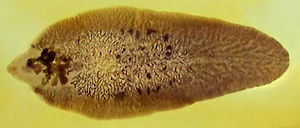| Also known as: | Liver Fluke |
Fasciola Hepatica is an hepatic parasite found in ruminants, namely cows and sheep. It is commonly found within the UK, with its prevalence ever increasing. It is responsible for a 10-15% production loss in each infected animal, as it affects meat, milk and wool production, so is of huge economic consequence.
Fasiola Hepatica has a definitive ruminant mammalian host and an intermediate molluscian host. The full life cycle is illustrated in the image aside.
- can cause severe haemorrhagic liver damage
- death in heavy infestations in sheep during migratory phase (1 month) through the liver tissue
- recovered animals will have scarred livers
- more commonly associated with chronic bile duct inflammation - cholangitis [need link to below]
- the adults live in the bile ducts
Acute Fascioliasis
- acute disease associated with immature fluke migration through the liver
- occurs in late autumn and winter
- severity of outbreaks depend on a number of epidemiological factors
- the liver of animals which die of this disease will be
- enlarged
- haemorrhagic
- honeycombed with the tracts of migrating flukes
- tracts become filled with blood and degenerate hepatocytes later infiltrated with eosinophils, lymphocytes and replaced by fibrosis
- surface is covered with a fibrinous peritonitis, especially the ventral lobe
- subcapsular haemorrhages are frequent
- rupture into the abdomen is not an uncommon finding
File:Fasciola hepatica - life cycle.jpg
Fasciola hepatica life cycle(Copyright Centres for Disease Control and Prevention)
Chronic Fascioliasis
Gross
- liver is reduced in size, unevenly
- left lobe is most severely affected with atrophy of the extremities
- hypertrophy may occur in some cases
- dorsal lobe
- this changes size and distorts shape of liver
- the surface will be uneven with areas of fibrous tissue replacing the cells damaged by the migrating flukes
- bile ducts
- prominent thick protruding white bile ducts on the visceral surface spreading from the hilus to the left lobe
- the bile ducts are dilated, black, and calcified on cut surface
- numerous adult flukes can be expressed from the bile ducts
- chronic cholangitis
- 'pipe stem' appearance in cattle because bile ducts are very much thickened and often calcified
- bile
- dark brown, thick, and gritty in consistency
NB: the fibrosis which occurs in the chronic stage is realted only partly to the healing of the migratory tracts and the rest may be related to the development of immunity and rechallenge
Microscopically
- reactive hyperplasia of the bile ducts
- substantial inflammatory cell infiltrate and peripheral fibrosis
- calcification of the chronically damaged tissue
